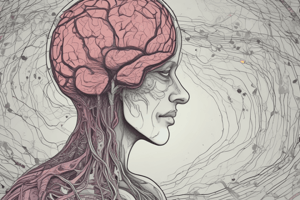Podcast
Questions and Answers
What is the primary response when the BIS is activated?
What is the primary response when the BIS is activated?
- A general sense of uncontrollability
- A feeling of calmness
- A tendency to fight
- An immediate alarm-and-escape response (correct)
How can upbringing influence a child's sense of control?
How can upbringing influence a child's sense of control?
- A secure home base encourages exploration (correct)
- Positive interactions with parents lead to a sense of uncertainty
- Constant supervision minimizes stress
- Overprotective parenting fosters independence
What types of events are most likely to trigger biological and psychological vulnerabilities to anxiety?
What types of events are most likely to trigger biological and psychological vulnerabilities to anxiety?
- Financial troubles
- Social and interpersonal stressors (correct)
- Natural disasters
- Physical illness
What contributes to a general sense of uncontrollability according to psychological factors?
What contributes to a general sense of uncontrollability according to psychological factors?
In what way do family dynamics affect reactions to stress?
In what way do family dynamics affect reactions to stress?
What is a characteristic of Separation Anxiety Disorder?
What is a characteristic of Separation Anxiety Disorder?
How is fear transmitted in the context of specific phobias?
How is fear transmitted in the context of specific phobias?
Which treatment approach is effective for specific phobias?
Which treatment approach is effective for specific phobias?
What might a child with Separation Anxiety Disorder experience during sleep?
What might a child with Separation Anxiety Disorder experience during sleep?
What role do parents play in the treatment of Separation Anxiety Disorder?
What role do parents play in the treatment of Separation Anxiety Disorder?
Which of the following is NOT a diagnostic criterion for Separation Anxiety Disorder?
Which of the following is NOT a diagnostic criterion for Separation Anxiety Disorder?
After treatment for specific phobias, which areas show increased responsiveness?
After treatment for specific phobias, which areas show increased responsiveness?
What type of behavior is common in children with Separation Anxiety Disorder when leaving home?
What type of behavior is common in children with Separation Anxiety Disorder when leaving home?
Which symptom is commonly associated with Separation Anxiety Disorder?
Which symptom is commonly associated with Separation Anxiety Disorder?
What is a requirement for diagnosing Separation Anxiety Disorder in children?
What is a requirement for diagnosing Separation Anxiety Disorder in children?
In which situation does Social Anxiety Disorder typically manifest?
In which situation does Social Anxiety Disorder typically manifest?
Which of the following is NOT a diagnostic criterion for Social Anxiety Disorder?
Which of the following is NOT a diagnostic criterion for Social Anxiety Disorder?
What physical reactions might someone with Social Anxiety Disorder experience?
What physical reactions might someone with Social Anxiety Disorder experience?
Which feature distinguishes Social Anxiety Disorder from Generalized Anxiety Disorder?
Which feature distinguishes Social Anxiety Disorder from Generalized Anxiety Disorder?
What duration is typically required for diagnosing adults with Separation Anxiety Disorder?
What duration is typically required for diagnosing adults with Separation Anxiety Disorder?
Which term refers to the fear in Japan that is similar to Social Anxiety Disorder?
Which term refers to the fear in Japan that is similar to Social Anxiety Disorder?
What is a common symptom of Post Traumatic Stress Disorder?
What is a common symptom of Post Traumatic Stress Disorder?
Which factor does NOT contribute to the diagnosis of PTSD?
Which factor does NOT contribute to the diagnosis of PTSD?
How long after a traumatic event can PTSD be diagnosed?
How long after a traumatic event can PTSD be diagnosed?
What is a significant feature of Acute Stress Disorder?
What is a significant feature of Acute Stress Disorder?
Which behavior is characteristic of someone suffering from PTSD?
Which behavior is characteristic of someone suffering from PTSD?
What does the 'dissociative' subtype of PTSD involve?
What does the 'dissociative' subtype of PTSD involve?
Which of the following is NOT a symptom of PTSD?
Which of the following is NOT a symptom of PTSD?
What represents a possible delay in the onset of PTSD symptoms?
What represents a possible delay in the onset of PTSD symptoms?
Which of the following is a key characteristic of Adjustment Disorder?
Which of the following is a key characteristic of Adjustment Disorder?
What is a defining feature of Reactive Attachment Disorder?
What is a defining feature of Reactive Attachment Disorder?
Which type of compulsion is most commonly associated with Obsessive-Compulsive Disorder?
Which type of compulsion is most commonly associated with Obsessive-Compulsive Disorder?
Which of the following is an example of Disinhibited Social Engagement Disorder?
Which of the following is an example of Disinhibited Social Engagement Disorder?
Which statement best describes thought-action fusion in the context of Obsessive-Compulsive Disorder?
Which statement best describes thought-action fusion in the context of Obsessive-Compulsive Disorder?
What is a typical pattern of behavior in individuals with Obsessive-Compulsive Disorder?
What is a typical pattern of behavior in individuals with Obsessive-Compulsive Disorder?
What differentiates Adjustment Disorder from Post-Traumatic Stress Disorder (PTSD)?
What differentiates Adjustment Disorder from Post-Traumatic Stress Disorder (PTSD)?
Which of the following is NOT a component of Obsessive-Compulsive Disorder?
Which of the following is NOT a component of Obsessive-Compulsive Disorder?
Flashcards are hidden until you start studying
Study Notes
Behavioral Inhibition System
- BIS activation leads to freezing, anxiety, and cautious situation appraisal
- BIS is a distinct circuit from the panic circuit, partially affected by serotonin levels
- Stimulating the BIS in animals results in an immediate alarm and escape response resembling human panic
Psychological Contributions to Anxiety
- General sense of uncontrollability arises from the understanding that events are often outside our control
- This sense may develop early due to disruptive or traumatic upbringing and environmental factors
- Positive and predictable parental interaction, responding to children's needs, fosters a secure home base and allows them to explore and build coping skills, leading to a healthy sense of control
- Overprotective and over-intrusive parenting, shielding children from adversity, can hinder the development of a healthy sense of control
Social Contributions to Anxiety
- Stressful events can trigger biological and psychological vulnerabilities to anxiety
- Common stressors are social and interpersonal, including marriage, family, school, death, and pressure
- The same stressors can trigger both physical and mental reactions
- Family members play a role in anxiety transmission through modeling and copying behavior observed from parents and relatives
Specific Phobia
- Requires structured and consistent exposure-based treatment
- Therapists work with individuals, guiding them through exposure exercises involving the phobia object or situation
- Patients practice approaching the phobic situation at home
- Treatment reduces responsiveness in the fear-sensitive network and enhances prefrontal cortical activity
Separation Anxiety Disorder
- Characterized by exaggerated worry about harm befalling parents or other significant figures, or separation from them
- Children may refuse to go to school or leave home due to fear of separation from loved ones
- Symptoms include refusing to sleep alone and experiencing nightmares
- Treatment often involves parents to structure exercises and address parental reactions to childhood anxiety
- Real-time coaching of parents is also employed
Diagnostic Criteria for Separation Anxiety Disorder
- Developmentally inappropriate and excessive fear or anxiety concerning separation from attachment figures
- This fear manifests in at least three of the following:
- Distress anticipating or experiencing separation from home or attachment figures
- Worry about losing attachment figures or harm befalling them
- Worry about experiencing an event causing separation from attachment figures
- Reluctance or refusal to go out due to fear of separation
- Fear or reluctance about being alone without attachment figures
- Reluctance or refusal to sleep away from home without attachment figures
- Separation-themed nightmares
- Physical symptoms like headaches, stomachaches, nausea, or vomiting when separation occurs or is anticipated
- Persistent fear, anxiety, or avoidance lasting at least 4 weeks (children/adolescents) or 6 months (adults)
- Clinically significant distress or impairment in social, academic, occupational, or other areas of functioning
- Not better explained by other mental disorders
Social Anxiety Disorder
- Also known as social phobia, it goes beyond shyness
- Individuals experience difficulty performing social actions only when observed due to fear of scrutiny
- Performance Anxiety involves discomfort with specific actions in front of others, fearing embarrassment
- Anxiety-provoking physical reactions include blushing, sweating, trembling, urination issues ("bashful bladder")
- Cultural variations exist, including "Shinkeishitsue" in Japan and "Taijin kyofusho" and "Olfactory reference syndrome" in North America
Diagnostic Criteria for Social Phobia
- Marked fear or anxiety about one or more social situations involving potential scrutiny by others
- Examples include social interactions, observation, and performance in front of others
- In children, anxiety must occur in peer settings and not just during interactions with adults
Trauma- and Stressor-Related Disorders: Post Traumatic Stress Disorder
- Preceded by exposure to a traumatic event, whether directly experienced, witnessed, learned about through a close family member or friend, or repeatedly exposed to details of the event
- Results in:
- Flashbacks: reexperiencing the traumatic event
- Avoidance of reminders of the trauma
- Restriction or numbing of emotional responsiveness
- Memory impairment regarding aspects of the event
Post Traumatic Stress Disorder: Continued
- Chronic hyperarousal, startled easily, and prone to anger
- Reckless or self-destructive behavior
- Dissociative subtype: reduced arousal with feelings of unreality
- Difficulty sleeping and recurring intrusive dreams
- Feelings of guilt
- Diagnosis cannot be made until at least one month after the traumatic event
- Delayed onset: individuals may develop full-blown PTSD months or years after the trauma
- Acute Stress Disorder: similar to PTSD but occurring within the first month after the traumatic event, lasting 3 days to 1 month
Diagnostic Criteria for Post Traumatic Stress Disorder
- Exposure to actual or threatened death, serious injury, or sexual violence through one or more of the following:
- Directly experiencing the traumatic event(s)
- Witnessing the event(s) happening to others
- Learning about the traumatic event(s) occurring to a close family member or friend
- Repeated or extreme exposure to aversive details of the traumatic event(s)
Adjustment Disorder
- Anxious or depressive reactions to life stress, milder than acute stress disorder or PTSD, but impairing in work, school, relationships, or other areas of life
- Attachment Disorder: disturbed and developmentally inappropriate behaviors in children under five years old, hindering their ability to form normal attachments with caregivers
Attachment Disorder: Subtypes
- Reactive Attachment Disorder: children rarely seek out caregivers for protection, support, or nurturing; exhibit lack of responsiveness, limited positive affect, fearfulness, and intense sadness
- Disinhibited Social Engagement Disorder: children show no hesitations approaching adults; engage in inappropriately intimate behavior; willingly accompany unfamiliar adults
Acute Stress Disorder
- Similar to PTSD but occurs within the first month after the trauma, emphasizing the immediate severe reaction experienced by some
Obsessive-Compulsive and Related Disorders: Obsessive-Compulsive Disorder
- Characterized by intrusive and nonsensical thoughts, images, or urges (obsessions) that individuals try to resist or eliminate
- Compulsions are thoughts or actions used to suppress obsessions and alleviate relief
- Types of Obsessions and Associated Compulsions:
- Symmetry/exactness/ "just right"
- Forbidden thoughts or actions (aggressive, sexual, religious)
- Cleaning/contamination
- Hoarding
Causes of Obsessive-Compulsive Disorder
- Early experiences may teach individuals that certain thoughts are dangerous and unacceptable, leading to the belief that the terrible things they think might happen and they would be responsible
- Thought-action fusion: belief that thinking about something equates to doing it
- Strength of religious beliefs can influence intrusive thoughts
- Resistance to intrusive thoughts through suppression or neutralization
- Generalized biological and psychological vulnerabilities are necessary for the disorder to develop
Studying That Suits You
Use AI to generate personalized quizzes and flashcards to suit your learning preferences.




